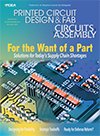Features Articles
 The demand for products that last is innovating design, processes and materials.
The demand for products that last is innovating design, processes and materials.
As the technology in our pockets, homes and offices becomes increasingly critical to our daily missions as individuals, we all value the reliability of these complex electronic devices. We depend on smartphones, communication networks, home office equipment, automobiles, contactless payment terminals and more to be ready for action every time we call on them. To meet our expectations, these systems must deliver high reliability.
Product manufacturers and brand owners understand the market value gained from establishing a reputation for reliability. They also understand that product reviews and social media channels give consumers immense power to make or break that reputation.
In general, the reliability of consumer-grade and industrial products has improved remarkably as the electronics industry has matured. This is due to a number of important factors. Component and interconnect technologies have improved enormously. Digital electronics offer much greater repeatability and robustness to changing operating conditions than ancient, predominantly analog circuits. And opening the enclosure of almost any consumer device typically reveals a tidy and minimalist assembly as integrated components internalize many interconnections and functions. On top of this, standardization of specialized functions such as RF transceivers as plug-and-play modules has made complex systems much easier to design and build using hardware that’s already proven in existing designs. Moreover, the vendors continually refine and improve these modules from one generation to the next.
 Worldwide collaboration still has a place in the printed circuit board supply chain.
Worldwide collaboration still has a place in the printed circuit board supply chain.
As time marches on and technology, as well as economic and geopolitical events, change and evolve, one thing is as true today as it was decades ago: It is still a small world, after all!
Being in a technology-driven industry, I often marvel at how small refinements to materials, processes and equipment, together, over time, are catalysts that enable truly significant technological advances. One person’s – or team’s – brilliant and possibly radical idea can become reality only when the little things are done in the way of refining existing materials, tweaking known processes and tuning the equipment necessary for its manufacturing. In almost all cases I can think of, the hype over so-called “game-changing” materials or processes, was for naught; the game did not change.
 You never know what you’ll find in the bushes.
You never know what you’ll find in the bushes.
A simple concept: Business development should qualify each lead or prospect to determine if the electronics manufacturing services company’s resources will be spent pursuing that prospective client.
The decision of “fit” should be the job of the senior business development professional, not the CEO, GM, COO or CFO. Elements of fit include the end product’s viability, the prospect’s financial standing, the tooling and capital equipment required to complete the job, the floor and warehouse space needed (in the case of a box-build program) and other elements of the deal.
How does a company know the fit is right unless properly vetted by a biz dev professional?
Case in point: When I was vice president of sales and marketing for a Florida-based mid-tier EMS, I received an intriguing call from an inventor in South Florida. I agreed to meet him at our factory to understand the product and requirements. After giving explicit directions to our visitors’ entrance, my admin called to say he arrived at the employees’ door. As an ITAR facility, specific protocols must be followed for proper vetting and sign-in. I asked the admin to let my guest in and escort him to the conference room after he executed the proper procedure and signed the appropriate paperwork.
 Ask questions now to save heartburn later.
Ask questions now to save heartburn later.
I have been selling PCBs for over 30 years and have numerous longtime customers with whom I’ve developed close friendships.
But as with any relationship, there are ups and downs. Given the dynamics involved in being a buyer under pressure to obtain good quality boards at the best possible price, or in my case, being a supplier expected to ensure those perfect PCBs are delivered on time and with no problems, things can sometimes get testy.
Frustrations can arise, especially when the supplier needs to maintain a profit margin either through raising prices or increasing the quantity of boards purchased, while the buyer is expected to constantly cut costs without hurting production.
 PCB designers can have many different career pathways.
PCB designers can have many different career pathways.
The route a PCB designer takes through the job market can lead to a number of different outcomes.
A board designer comes in with a knowledge set that helps transform an abstract schematic into physical electronics. A lot of that has to do with knowing what happens downstream from the day the artwork was created. The steps involved with PCB fabrication and assembly are complex, even for the simplest of jobs.
Take a factory tour and notice the rooms full of different machinery. Material is cut to shape and drilled in a kinetic energy field that makes so much noise. Vast plating lines do serial dunking in different vats of bubbling hazards. These are the CAD data manifested in copper for the first time.
Another room is more Zen, with tons of pressure and high temperature being applied. It’s a slow process, and the presses are very expensive. This is usually a small factory’s bottleneck. Down the hall, a brightly lit room full of automated optical inspection equipment ensures compliance. What we do on the monitors plays out across the factory.
 Will 2025 bring new solutions to familiar challenges?
Will 2025 bring new solutions to familiar challenges?
The desire to solve problems is ingrained in human nature. But we know that our solutions often create new problems. It’s a cycle that will likely never end.
So if you want to know what’s coming in 2025, the short answer is nothing we didn’t already know. Important trends will include, of course, more AI spreading from cloud to edge, as well as developments in commercial space exploration and sustainable technologies. Each of these presents exciting opportunities while also being the subject of dire warnings if things were to go wrong.
Elon Musk recently suggested that the chances of AI turning out badly are about 10-20%. That sounds alarmingly high. Without delving more deeply into his comment, a logical, if slightly facetious, response is that the chances of AI working in our favor must then be 80-90%. That sounds more encouraging. In practice, however, we must be prepared for good and bad outcomes. Legislation is beginning to arrive as technology acts proposed in the US and Europe put forward restrictions on the use of the AI, including prohibiting undesirable practices like deception, social scoring, biometric categorization and untargeted facial recognition.
Press Releases
- Mobius Materials Raises $3M to Combat One of Manufacturing’s Biggest Issues Amid US-China Trade Tariffs
- Kitron secures EUR 17 million contract for combat vehicle components
- Altus Reports Growing Demand for Guidance on Convection Reflow Oven Specification
- Coherix Opens New Adhesive-Dispensing Vision Center in Europe


